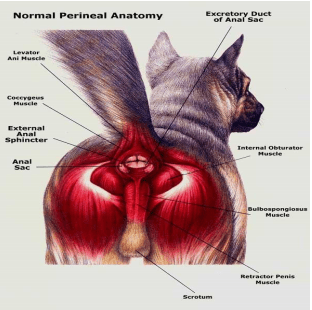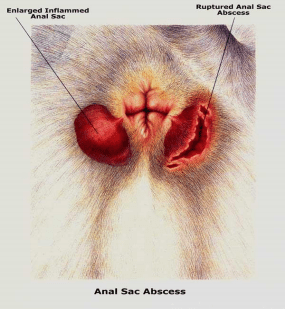Anal Glands
The anal sacs are a paired organ located just beneath the skin and anal sphincter at approx 5 and 7 o’clock. Tiny ducts lead to the tissue just inside the rectum. The colour and consistency of the material is of a brown, watery consistancy and very smelly. The glands are usually emptied as the hard faeces passes through the rectum expressing the fluid onto the faeces.
Changes in diet and soft consistency of the faeces may mean the anal glands are not squeezed; therefore a build up of the secretion within the anal glands occurs. When the fluid builds up and the animal ‘scoots’ to try to relieve the pressure and we have signs of an impaction. If the secretion stays in the sacs for a long time, it can begin to thicken. At this point it can become very difficult to express the secretion and the anal gland can become subject to bacterial invasion and abscessation. Once an abcess forms, a rupture through the skin may occur; this is a painful process.
Normally the anal sacs are the size of a kidney bean, but once impacted they can become the size of a walnut. They will need to be expressed by your veterinarian; this may have to be done a number of times. A change in diet may also be recommended to create a firmer stool and to allow for expression of the anal glands as the pet passes faeces. In some more serious cases the pet may require surgery to fix any rupture to the anal gland, or even removal of the anal sac due to constant impaction. Treatment for this condition can and may include:
- Periodic expression of the anal glands by the veterinarian
- Medication to help clear up any infection of the anal glands.
- Surgery to help repair any rupture or removal of the anal glands.


Pictures supplied by © 2009 Hill’s Pet Nutrition, Inc. Hills Anatomy Atlas”™”
